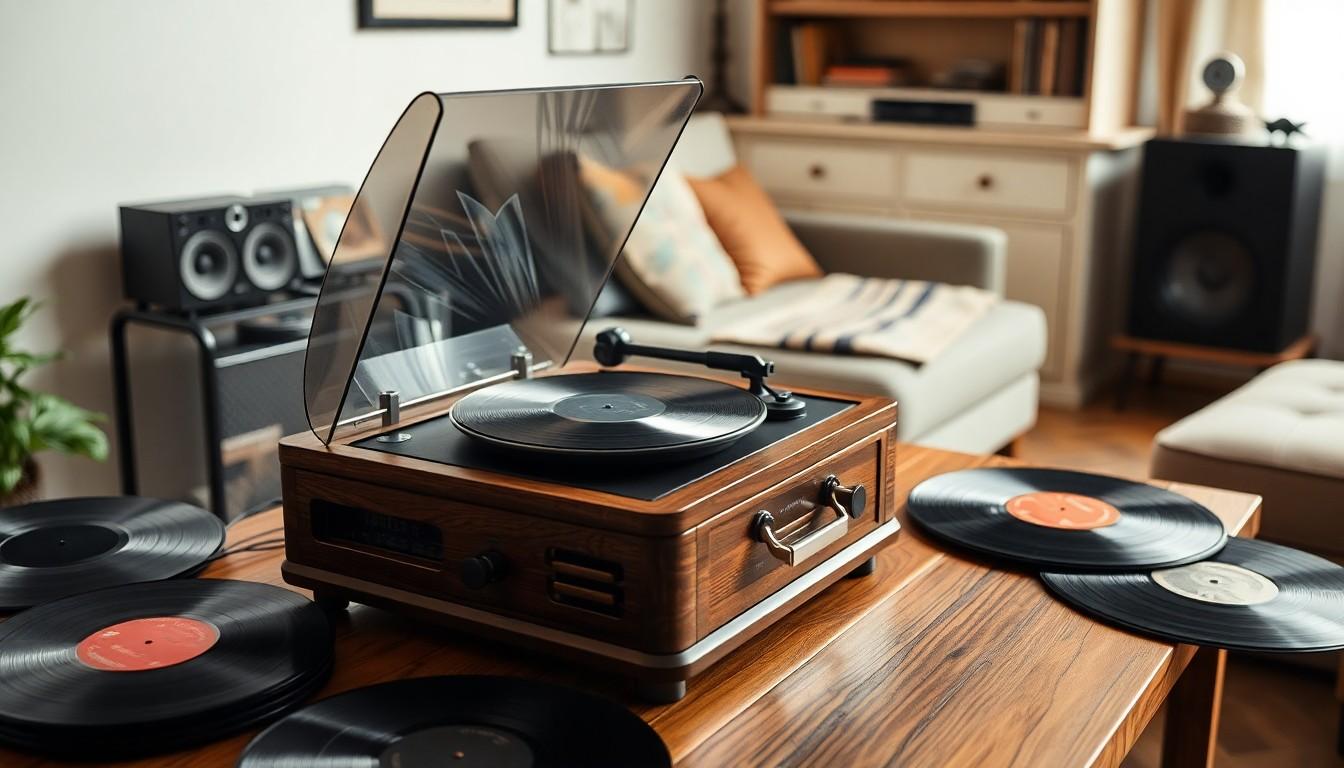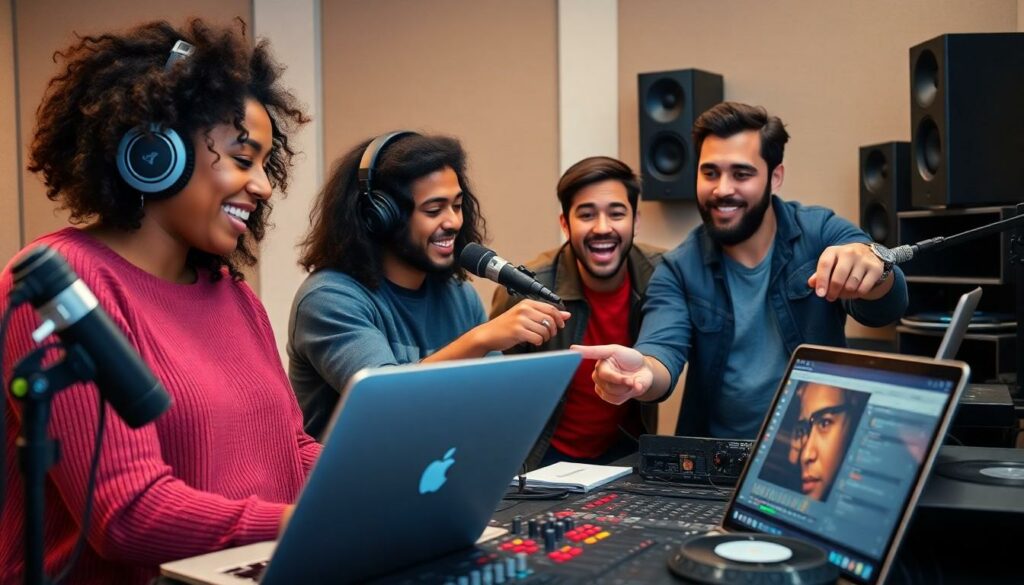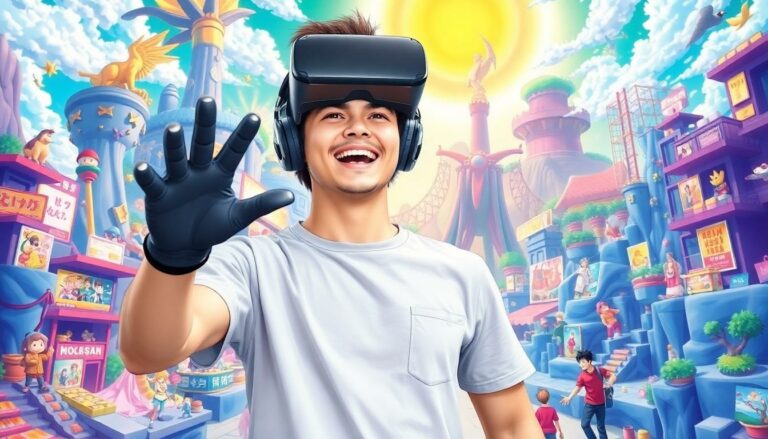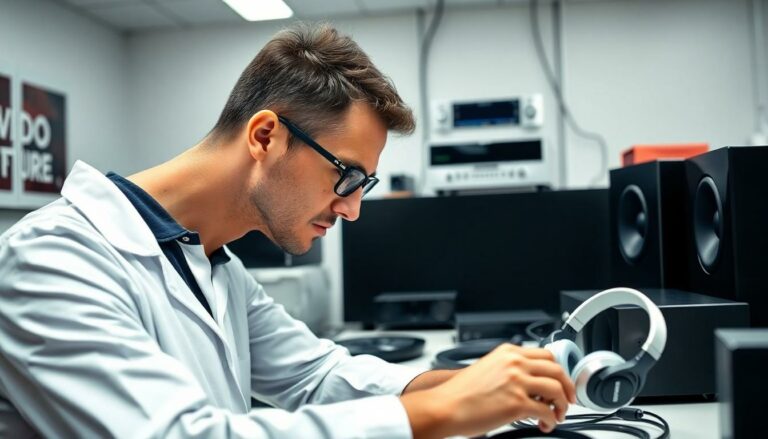Table of Contents
ToggleIn a world where music can be streamed at the touch of a button and audio technology evolves faster than a cat meme goes viral, it’s hard to keep up. From the vinyl revival to the rise of high-fidelity streaming, music and audio tech have transformed how people experience sound. Whether you’re a bedroom DJ or a casual listener, the right tools can turn any space into a concert hall—or at least a really cool living room.
Overview of Music and Audio Technology
Music and audio technology has transformed how individuals access and enjoy sound. Innovations continue to create new listening experiences and redefine industry standards. The rise of digital streaming platforms, such as Spotify and Apple Music, allows users to find songs instantly. Streaming services often deliver curated playlists and algorithm-driven suggestions, enhancing user engagement.
Vinyl records have surged back into popularity, showcasing a desire for analog sound quality. Audiophiles and casual listeners alike appreciate the warmth and depth of vinyl. Furthermore, high-fidelity streaming options like Tidal and Qobuz provide lossless audio formats, catering to discerning tastes. These platforms emphasize sound quality, ensuring that even the most nuanced details are preserved.
Home audio systems benefit from advancements in technology. Smart speakers featuring voice recognition let users control playback hands-free. Wireless connectivity enables convenience and ease of use, allowing seamless integration with home networks. Many users now seek multi-room setups to enhance their listening experience throughout spaces.
Innovative production tools are available for music creators. Digital Audio Workstations (DAWs) like Ableton Live or Logic Pro X offer powerful software for composing and editing music. Budget-friendly hardware instruments, such as MIDI controllers, simplify the production process for aspiring musicians. Smartphones can even serve as portable recording studios, increasing access for creators everywhere.
Sound engineering technology continues to advance, shaping the future of live performances. Advanced sound systems and mixing consoles ensure crystal-clear audio no matter the venue size. Virtual reality (VR) technology also emerges as a platform for immersive music experiences. These developments highlight the importance of staying current in this dynamic field.
Evolution of Music and Audio Technology

Music and audio technology has transformed significantly over the years, reshaping how individuals experience sound. Innovations have continuously enhanced user engagement and accessibility.
Historical Milestones
The invention of the phonograph in 1877 marked the beginning of recorded music. In 1925, the introduction of electric microphones revolutionized live performances. The 1960s saw the arrival of stereo sound, enriching listening experiences home and in concert venues. Digital recording emerged in the late 1970s, allowing for cleaner sound reproduction. The 1990s brought the compact disc, which quickly became the dominant format for music distribution. The rise of the internet in the early 2000s facilitated music sharing and laid the groundwork for streaming platforms. Each milestone fueled the evolution of music consumption and production.
Technological Advancements
Modern audio technology features a variety of breakthroughs making music more accessible. Digital Audio Workstations (DAWs) allow musicians to produce high-quality audio with minimal equipment. Smart speakers and wireless connectivity enable easy playback across multiple rooms. Streaming services like Spotify and Apple Music leverage algorithms for personalized listening experiences. Vinyl records have seen a resurgence, appealing to those wanting analog warmth. High-fidelity streaming platforms prioritize lossless audio formats and cater to audiophiles seeking premium sound quality. These advancements continuously redefine industry standards and consumer expectations.
Current Trends in Music and Audio Technology
Music and audio technology is constantly evolving, impacting how creators and consumers engage with sound.
Digital Audio Workstations
Digital Audio Workstations, or DAWs, play a pivotal role in modern music production. Musicians utilize software like Ableton Live and FL Studio to create and edit music seamlessly. With user-friendly interfaces, these tools enable both novices and seasoned professionals to produce tracks without extensive technical knowledge. The affordability of many DAWs makes high-quality music creation accessible to a wider audience. Enhanced features, such as built-in virtual instruments and effects, further empower users to experiment with their sound. Today’s DAWs promote collaboration, allowing multiple users to work together in real-time, regardless of physical location.
Streaming Services
Streaming services dominate the music landscape today, reshaping how listeners consume audio. Platforms like Spotify and Apple Music provide vast libraries of songs accessible with a simple touch. Curated playlists and algorithm-driven recommendations enhance the user experience, allowing listeners to discover new music tailored to their preferences. High-fidelity streaming options have emerged, appealing to audiophiles seeking superior sound quality. Additionally, these platforms often feature exclusive content like artist interviews and live sessions, enriching the user’s connection to the music. Subscription-based models provide artists with a new revenue stream, transforming the financial landscape of the music industry.
Impact on Music Creation and Production
Music and audio technology significantly influence the creation and production landscape. These advancements reshape the roles of musicians and sound engineers, fostering innovation.
Accessibility for Musicians
Access to music production tools has broadened, allowing more artists to enter the industry. Digital Audio Workstations, known as DAWs, provide intuitive interfaces for composition and editing. These platforms, including Ableton Live and FL Studio, require less technical expertise, inviting diverse talent. Budget-friendly hardware instruments further enhance this accessibility, making quality production equipment available. Online tutorials and communities support aspiring musicians, offering guidance and collaboration opportunities. This democratization of music creation enables a wider array of voices to be heard in the industry.
Changes in Sound Design
Sound design has evolved dramatically, showcasing technological advancements in the field. Software synthesizers and various sampling techniques expand sonic possibilities, encouraging creativity. Virtual instruments allow for intricate sound layering and manipulation, leading to unique compositions. Innovations in audio processing enable musicians to experiment with effects in real time, enhancing dynamic range. Furthermore, the integration of artificial intelligence into music production tools streamlines the creative process, providing intelligent recommendations. These developments transform sound design, encouraging artists to push boundaries and explore new musical realms.
Future of Music and Audio Technology
The future of music and audio technology promises exciting developments and potential hurdles. As technology advances, it will redefine how creators and listeners interact with sound.
Innovations on the Horizon
Advancements like spatial audio and immersive sound experiences are on the brink of mainstream adoption. These innovations enhance the listening experience by creating a three-dimensional sound stage that envelops audiences. Artificial intelligence plays an increasingly significant role, automating sound production and personalization through tools that analyze user behavior. Additionally, blockchain technology is set to revolutionize rights management, allowing artists to control their content while ensuring fair compensation. Collaborative platforms are emerging, enabling musicians to collaborate remotely in real time, expanding creative possibilities and participation. Expect ongoing growth in virtual and augmented reality environments that bring live music experiences directly to fans, bridging distances with interactive formats.
Potential Challenges
Rapid advancements come with obstacles that the industry must address. Intellectual property issues surrounding AI-generated music and copyright infringement could lead to legal complexities. Furthermore, the transition to new technologies often presents compatibility issues with existing systems, complicating workflows for sound engineers and producers. Maintaining audio quality while incorporating wireless solutions remains a technical challenge in achieving seamless multi-room setups. Additionally, ensuring equitable access to advanced tools for all artists is vital to avoid a wider talent gap. Training in new technologies must keep pace with innovation, as many creators seek guidance on using increasingly sophisticated tools. These challenges require proactive strategies to cultivate a thriving music and audio technology landscape.
The landscape of music and audio technology continues to evolve at a breathtaking pace. As innovations reshape how sound is created consumed and experienced there’s an undeniable excitement in the air. From the revival of vinyl to the rise of high-fidelity streaming services each advancement brings new possibilities for both artists and listeners.
With tools becoming increasingly accessible aspiring musicians can now explore their creativity without barriers. The integration of AI and immersive sound experiences promises to further revolutionize the industry making music more engaging than ever. While challenges remain the future holds immense potential for those willing to adapt and innovate. Embracing these changes will ensure that music remains a vibrant and dynamic part of our lives.




